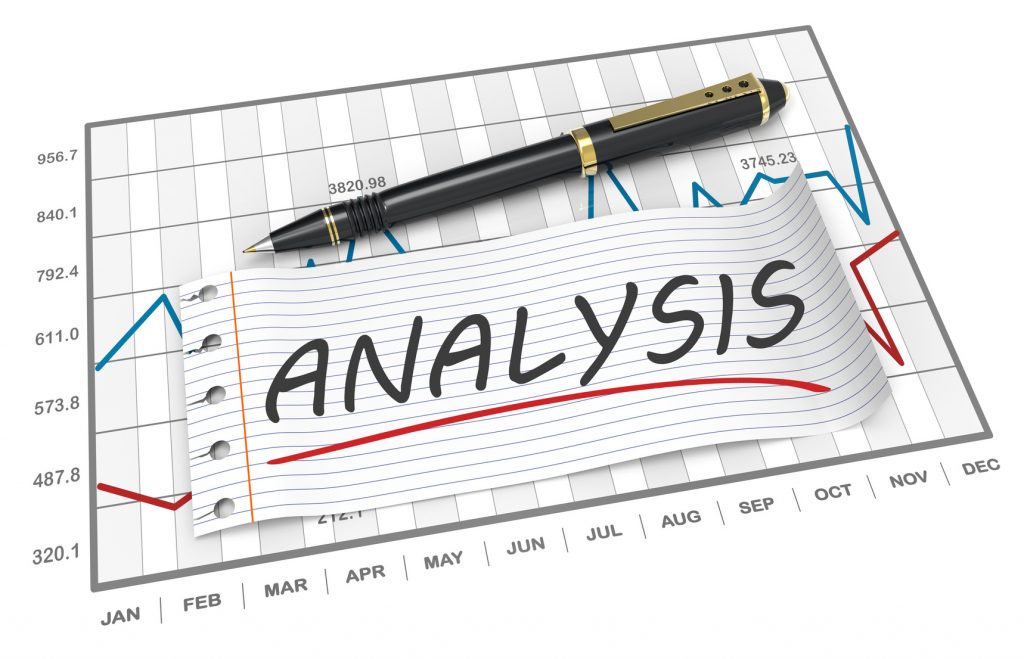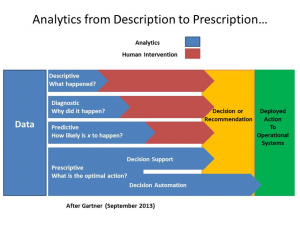Prescriptive analytics is a relatively recent development beyond the broader disciplines of predictive analytics and data science. In this blog post I want to explain a bit about what it is and discuss why I think many organisations are already on the road to using it, without even knowing it.
Prescriptive analytics is the third of three phases of analytics. Phase one, descriptive analytics, is about mining historical data to understand the reasons behind past performance. Phase two, predictive analytics, uses rules and algorithms to determine the probability of an event occurring in the future. Phase three, prescriptive analytics, takes this one step further, not only predicting future outcomes but also suggesting suitable actions a business might take in order to benefit from the predictions, and calculating what the implications of each possible action would be.
Below is a helpful schematic, adapted from original work by Gartner, which will help position prescriptive analytics:
So, having explained what prescriptive analytics is, I’m now going to suggest 10 reasons why you may be closer to using it in your organisation than you think.
- Your organisation is likely to already have many of the building blocks of prescriptive analytics in place without even realising it. Everyone has some form of management reporting system nowadays, right? Once you have that then you’re on the road to being able to do sophisticated prescriptive analytics.
- Descriptive and diagnostic analytics are useful tools for helping to manage your business based on looking backwards. Using these approaches also helps educate stakeholders about the value of organisational data, meaning that they’re much more likely to recognise the value of data as an organisational asset. Once that mindset is established then people are likely to be much more open to the possibilities of predictive and, ultimately, prescriptive analytics.
- Predictive analytics, when used well, proves the competitive value of prediction. It also helps business owners and operators to realise the value of going beyond static, retrospective analysis towards predictive models used in real or near-real time.
- At some point the output of predictive analytics (often a number representing a likelihood, a risk or a propensity) bumps into some existing set of business rules e.g. In the event of ‘A’ always do ‘B’, or a suppression list or a compliance regulation etc. It is at this confluence of prediction and business rules that the prescriptive spark is ignited.
- Add into the mix the plentiful descriptive data that most organisations hold – how many incidents, how many operatives in which locations, how much inventory, how much value per sale and so on. This descriptive data gives a good environment for optimising and presenting prescriptive decision options and recommendations in a way that reflects the business’s true situation.
- Layer in the existence of sophisticated and highly configurable (and affordable) rules engines. Think of things such as CPLEX and the like and pretty much all the ingredients of prescription are either already in place or at least available and feasible.
- If your organisation has, or is in the process of developing, predictive analytical skills then, taken together with existing business intelligence and management information capabilities, then you probably already have people in your organisation with the necessary skills and expertise to take you towards prescriptive analytics.
- Consider your existing IT infrastructure and the multitude of systems that your organisation probably already uses and how the data from them could be integrated. Historically ‘systems integration project’ was a phrase to send a shiver down the spine of even the hardiest IT leader. However modern technology such as (almost) ubiquitous APIs and web services mean that the dynamic exchange of data from one system to another need no longer be a headache. In many respects it is the life blood of deployed predictive and now prescriptive analytics.
- Prescriptive analytics doesn’t require the implementation of new operational IT systems and the replacement of some existing systems. Think about it as a series of sophisticated software components, specialist applications and new data fields (recommendations and likelihood scores) that bind together current operational systems with new automated decisions / recommendations and processes.
- The continued evolution of business analytics from simple descriptions to diagnostic data to prediction and now to prescription is another form of intellectual property. Its benefit can be measured against its cost and the value is tangible. Which organisation, of any scale, would not be interested adding further value to the bottom line and to its business as a whole?
One final point to consider. The move to prescriptive analytics can be planned and deployed in phases and, as we’ve seen, many of the building blocks needed to make it happen are likely to already be in place in your organisation. Developing augmented and automated decision processes in one area or process at a time. This reduces risk, enables your organisation to manage investment carefully and enables positive results to be delivered before moving to the next phase.



